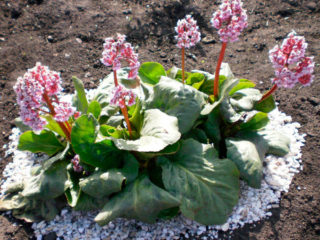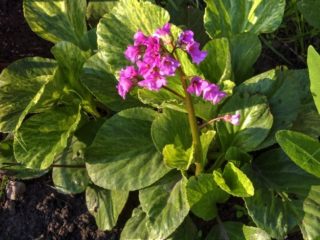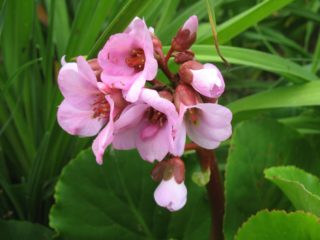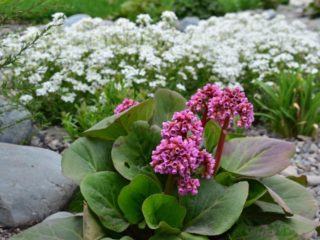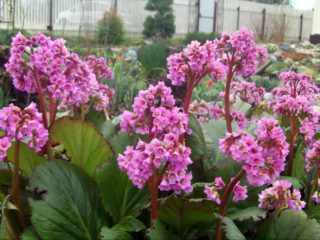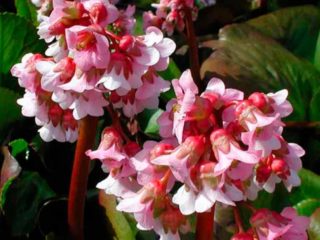Content
Badan Bressingham White is a lush plant with bright green foliage that immediately catches the eye in a flower bed. At the same time, it does not require special care, so even a novice gardener can grow it.
Description
The evergreen herb badan belongs to the Saxifrage family. He also has another, unofficial name - "Elephant Ears", which he received thanks to his large fleshy leaves.
One of the popular varieties is Bressingham White. The root system is well developed and located close to the soil surface. During the flowering period, long peduncles 20-50 cm high are formed with numerous buds in the shape of a glass. The diameter of the flowers is 2-3 cm, and the color, depending on the variety of bergenia, can be from white to rich pink-lilac. Flowering begins in early spring, immediately after the snow melts, and lasts about 1.5 months.
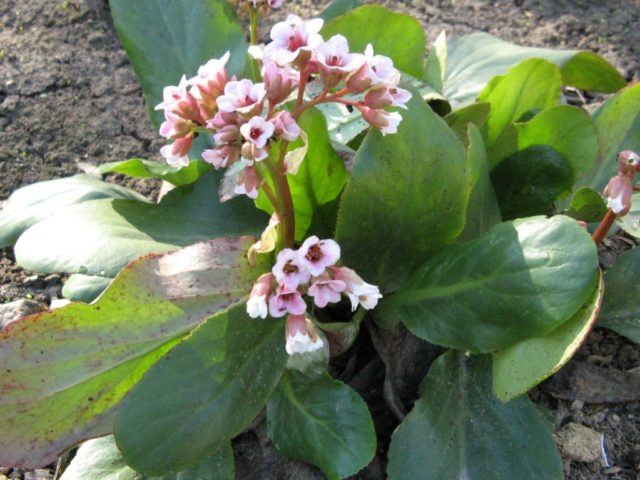
For bergenia, partial shade is preferable
With the onset of autumn, the leaves of the flower acquire a reddish color. The darkened leaf plates of badan left after wintering can be used to make aromatic tea with a number of useful properties. It is used to normalize blood pressure, improve the functioning of the digestive system, cleanse blood vessels and stimulate immunity.
Hybrid history
In the wild, badan is most often found in Asia - it grows in Mongolia, Kazakhstan, China, Altai and in a number of other regions. Many varieties are found only in a limited area and are listed in the Red Book.
Breeders' interest in this flower arose in the 18th century. Most of the hybrids were obtained on the basis of wild-growing thick-leaved bergenia. As a result, botanists were able to breed specimens with more lush foliage and larger flowers than the original plant.
Badan variety "Bressingham", which was bred by English scientists and got its name in honor of a plant nursery in Norfolk County, where breeding work was carried out, is no exception.
Badan varieties Bressingham (Bressingham)
The Bressingham badan hybrid includes several varieties that are distinguished by their compact size and large dense inflorescences. The main difference between them is the color of flowers and leaves.
White
The variety "Bressingham White" (Bressingham White) - one of the most popular and common badans, planted in flower beds. Its height is about 30 cm. Leaves of deep green color form a dense rosette. The flowers are white in color and are collected in lush inflorescences. The flowering period is May-June. Possesses high frost resistance.
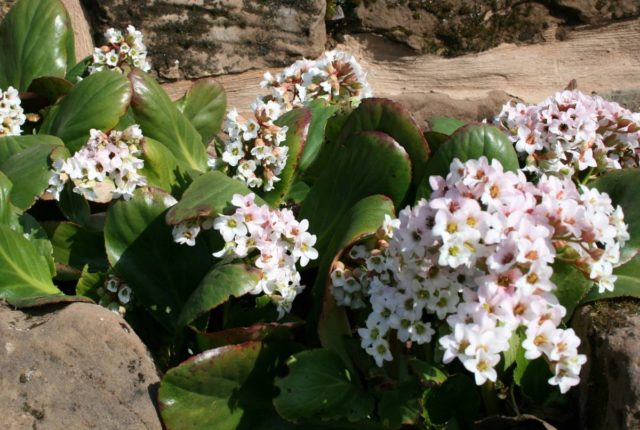
Flowers "Bressingham White" have bell-shaped inflorescences
Ruby
Badan "Ruby" got its name from the bright pink inflorescences and color of the leaves - it is bright green in the center and turns into red at the edges. Plant height 35-40 cm. Rhizome is thick aboveground, about 1 m long. In early spring, vertical peduncles appear, on which lush flowers bloom a little later. Flowering lasts about 3 weeks.
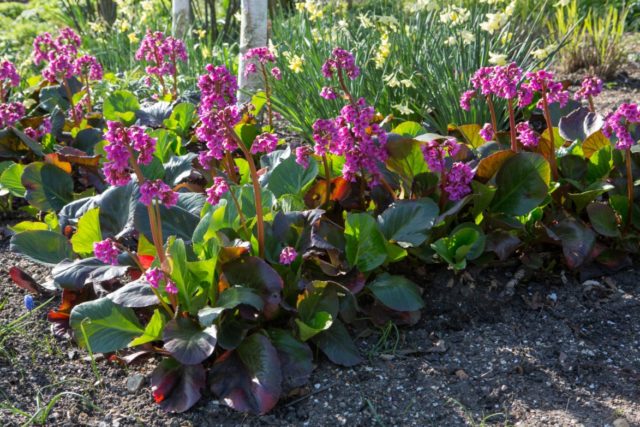
The Ruby variety feels most comfortable in slightly shaded areas.
Salmon
Sort "Salmon" (Salmon) reaches a height of 25-35 cm. It has large leathery leaves, which in summer have a bright green color, and by autumn they become purple-burgundy.The flowers are salmon pink, located on dark red stems.
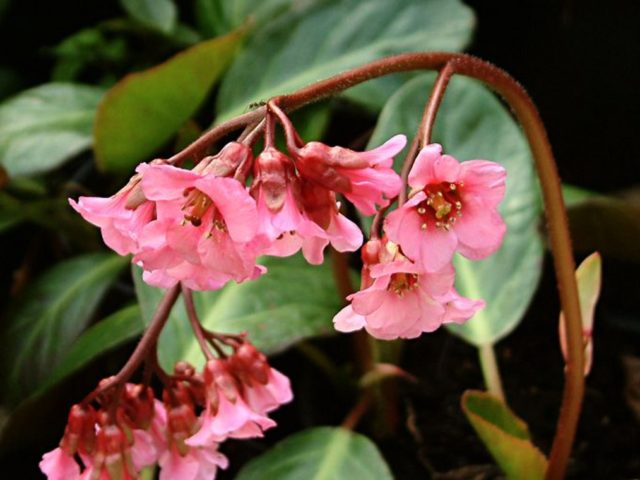
Bressingham Salmon bloom in late April
Beauty
The Beauty variety is a hybrid about 30 cm high. Like other varieties, Bressingham prefers shaded areas with well-drained soil. The color of the petals is dark pink.
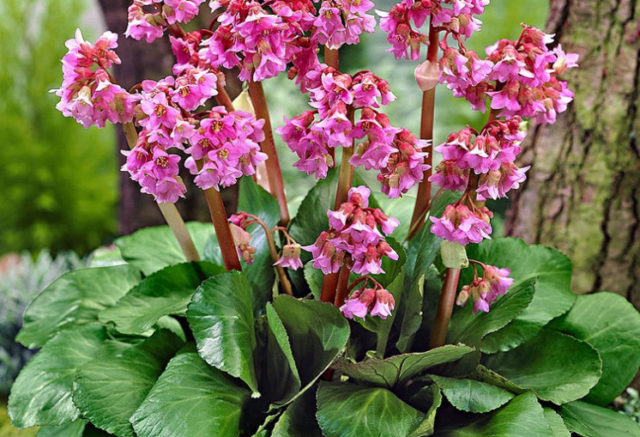
Bressingham Beauty Blossom Period - May-June
Bountiful
Another not very common, but very beautiful hybrid is Bountiful. Its height can reach 40 cm. Flowers located on high peduncles have a pale pink color.
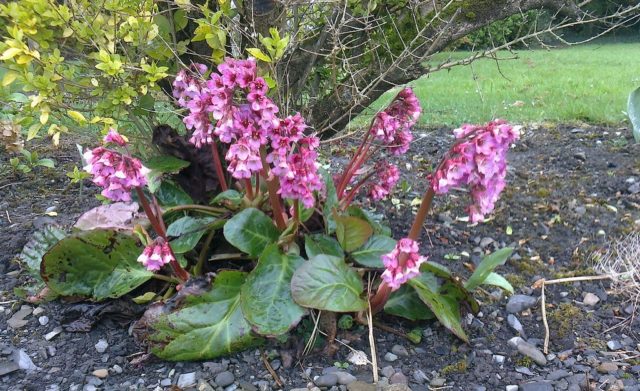
The leaves of "Bantiful" are dark green in summer, and acquire a reddish tint by winter.
Growing from seeds
Growing badan "Bressingham White" from seeds is a simple process that requires compliance with certain rules. First of all, you need to know that the seeds of the plant require stratification. For this, the seeds are sown in specially prepared containers, sprinkled with a layer of snow and, if possible, buried in a snowdrift for 3 months or placed in a refrigerator for the same period (the temperature should not exceed 3 ° C). Growing seedlings from Bressingham White berry seeds includes several stages:
- At the beginning of March, the containers are moved from the refrigerator to a warm place. At a temperature of about +20 ° C, the sprouts should appear within 20 days.
- After the formation of shoots, they must be regularly sprayed, and in case of thickening, thinned out by removing the weakest shoots with scissors.
- From the beginning of May, the seedlings can be hardened by taking them out into the open air, gradually increasing the time.
Badan "Bressingham White" is transplanted into open ground after the night frosts are over, and the temperature at night does not drop below +12 ° C.
Landing in open ground
"Bressingham White" is a very unpretentious variety that can grow in almost any region of our country. At the same time, when choosing a place for its planting, one should take into account the climatic conditions of a particular area. When it comes to arid regions, a shaded area located under trees or next to buildings is best suited. When planting in the middle lane, where summer is rarely hot, a sunny place is also suitable. In both cases, an excellent solution would be the proximity of the plant to the reservoir.
Badan "Bressingham White" grows well on light loose soil. This is due to the peculiarities of its root system - the rhizome is located near the surface of the soil, and due to its looseness, it receives moisture and nutrients in the required volume. It is often possible to notice that the rhizome has come out, so the ground around the flower needs to be mulched, this is especially true in sunny, unshaded areas. At the same time, the composition of the soil for Bressingham White is not so important - moisture plays a more significant role, which should not be excessive.
Landing in open ground begins in June, when there is no longer a threat of night frosts. Seedlings are placed in pre-prepared pits 7-8 cm deep. Sand or pebbles can be poured into the bottom of the holes as drainage.
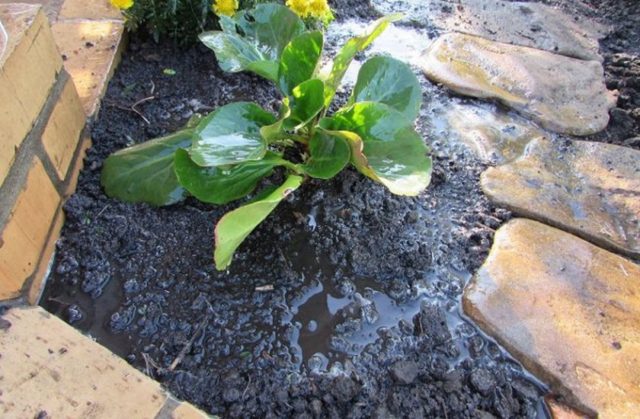
After transplanting, berry must be watered abundantly
For the first time after transplanting, the flowers can be covered with a non-woven material to protect them from wind and sunlight.
Care
Caring for "Bressingham White" is very simple because of its unpretentiousness. It should be remembered that the flower does not grow well on overdried soil, therefore it requires regular watering.
The lower leaves that have lost their freshness should not be removed - they will help to retain moisture in the soil and will cover the roots that are close to the surface from drying out. If the leaves still spoil the appearance of the plant and you want to remove them, the soil around the berry should be sprinkled with mulch.
After the end of flowering in early summer, the peduncles are cut off, if it is not planned to collect seeds.Under favorable climatic conditions, re-flowering is possible at the end of summer.
Growing up, Bressingham White berry densely covers the ground around with foliage. Therefore, there are practically no weeds nearby, which means that weeding is not required.
There is no particular need to apply fertilizers - with an excess of fertilizing, the leaves begin to grow stronger, and flowering does not occur. The only exception may be a single complex feeding after the end of flowering.
Badan "Bressingham White" does not react well to transplants, so it should not be transferred without an urgent need. In one place, badan can grow well for more than 10 years. It should only be borne in mind that, expanding in breadth, it can displace other plants from the flower bed. To avoid this, it is recommended to limit the area with stones or curbs.
Diseases and pests
Badan is a plant with strong immunity, so it practically does not suffer from diseases and all kinds of pests. The only and common problem is the invasion of snails and weevils, which can severely damage the foliage. To prevent this, you should monitor the condition of the plant, and if pests appear, remove them in a timely manner.
Pruning
By the end of autumn, before the onset of frost, old dead leaves should be removed - it is better not to cut them off, but to pull them out together with the cuttings. After winter, it is necessary to remove dried foliage so that it does not interfere with the development of fresh foliage.
After the end of flowering, if the task of collecting seeds is not worth it, you can immediately cut off wilted inflorescences.
Shelter for the winter
Badan belongs to frost-resistant crops and can easily withstand temperatures down to -30-40 ° C. But it should be borne in mind that badan can survive the winter well only in the presence of snow. If winter with little snow is expected, the roots of badan, which are located near the surface, may freeze. Therefore, it is better to take care of their shelter - dry foliage and spruce branches are suitable for this.
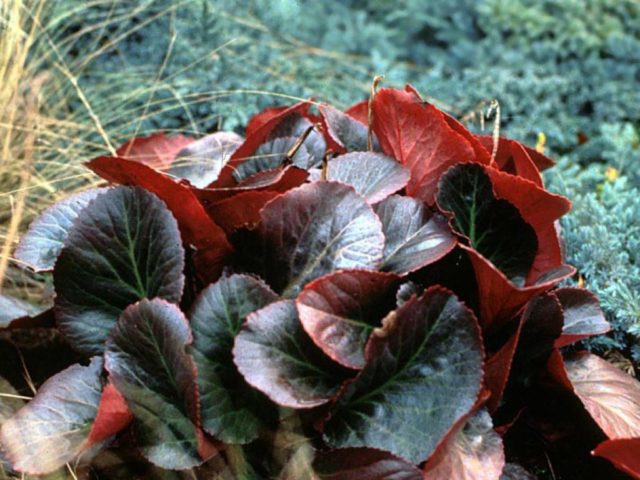
Badan leaves begin to turn red by winter
If in winter the temperature does not drop below 10 ° C, you do not need to cover the berry.
Reproduction
It is very easy to propagate Bressingham White badan. There are several ways, among which you can choose the most suitable:
- Dividing the bush - in spring or autumn, the plant is divided into several parts and planted in different places. This method is also very convenient in that it does not allow the berry to grow and fill the entire flower bed. This division is recommended to be carried out periodically - once every several seasons.
- Root cuttings - the rhizome "Bressingham White" is divided into several parts of 2-3 cm and rooted in containers filled with a mixture of sand and peat. After the shoots appear, they are seated in separate pots.
- Cuttings - at the beginning of summer, the rosettes with a part of the rhizome and several leaves are cut off and rooted in the ground.
- Seeds - they need stratification, then they are planted in prepared containers. The seedlings are transferred to the open ground in early spring, after the end of the frost.
Photo in landscape
Badan "Bressingham White" and other varieties are great for decorating flower beds and garden plots. They look spectacular both in single planting and in landscape composition.
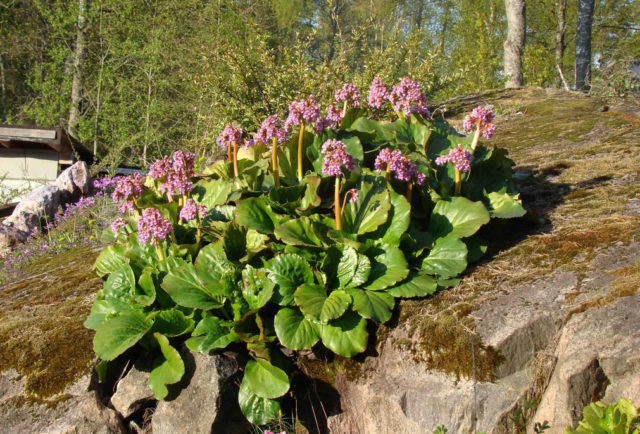
Badan feels great in elevated sunny areas
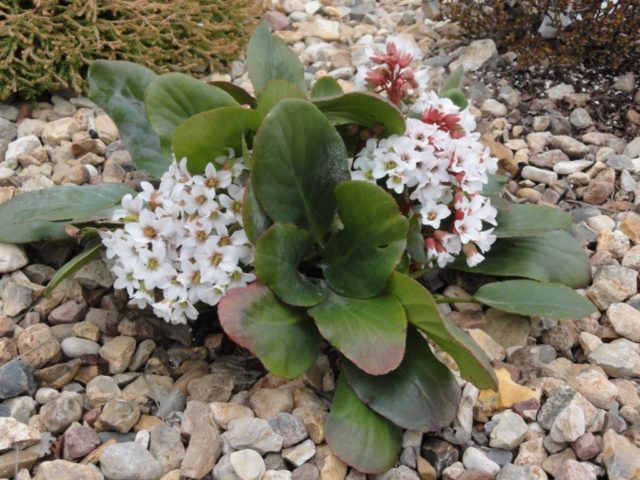
Badan grows well among stones
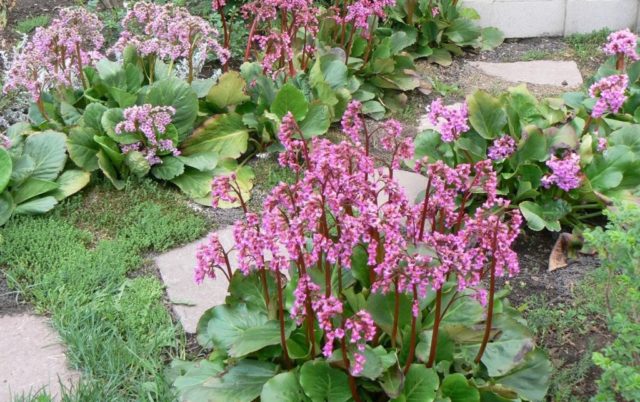
Against the background of conifers, badan will be a bright accent
"Bressingham White" is suitable for creating stepped landscape solutions, occupying the lower tier under the bushes. Thanks to its large, lush foliage, it does not get lost near buildings and garden fences.
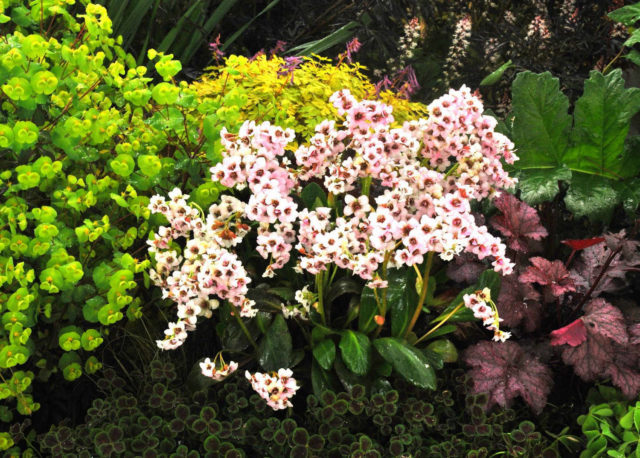
Badan is in perfect harmony with hosta and ferns
Conclusion
Badan Bressingham White is an unpretentious ornamental plant that is great for decorating garden and house plots.Minimal care is required, it practically does not suffer from diseases and pests and even tolerates severe frosts well. Moreover, it looks great both in flower arrangements and when planted separately.
